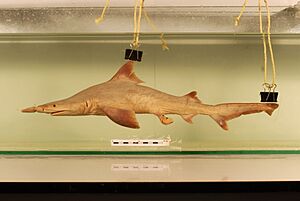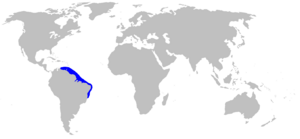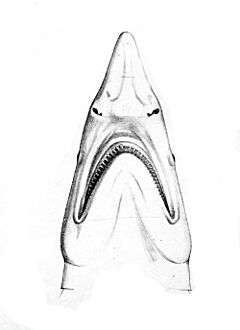Daggernose shark facts for kids
Quick facts for kids large shark |
|
|---|---|
 |
|
| Conservation status | |
| Scientific classification | |
| Genus: |
Isogomphodon
|
| Species: |
oxyrhynchus
|
 |
|
| Range of the daggernose shark | |
| Synonyms | |
|
Carcharias oxyrhynchus Müller & Henle, 1839 |
|
The daggernose shark (Isogomphodon oxyrhynchus) is a special type of requiem shark. It is the only living member of its group, called a genus. This shark lives in shallow, warm waters near northeastern South America. You can find it from Trinidad all the way to northern Brazil. It loves muddy places like mangroves, estuaries, and river mouths. But it cannot live in fresh water.
This shark is quite small, usually about 1.5 meters (5 feet) long. It's easy to spot because of its unique snout. The snout is long, flat, and very pointed, like a dagger! It also has tiny eyes and big, paddle-shaped pectoral fins. Daggernose sharks hunt small schooling fishes. Female sharks give birth to 2 to 8 pups every two years during the rainy season. They can even change when they have their babies based on the environment.
This shark is not dangerous to humans. However, it is often caught by accident by local and commercial fishermen. Because it lives in a small area and reproduces slowly, its population has dropped a lot. The International Union for Conservation of Nature (IUCN) has listed it as Critically Endangered. This means it is at a very high risk of becoming extinct. Scientists believe there are fewer than 250 daggernose sharks left.
| Top - 0-9 A B C D E F G H I J K L M N O P Q R S T U V W X Y Z |
What's in a Name? The Daggernose Shark's Story
The daggernose shark got its first scientific name, Carcharias oxyrhynchus, in 1839. Two German scientists, Johannes Peter Müller and Friedrich Gustav Jakob Henle, described it. They picked the name oxyrhynchus because of its sharp nose. In Greek, oxys means "sharp" and rhynchos means "nose."
Later, in 1862, an American scientist named Theodore Gill gave it a new genus name: Isogomphodon. This name also comes from Greek words. Isos means "equal," gomphos means "nail" or "peg," and odous means "tooth." This refers to its teeth. For a while, scientists thought Isogomphodon was the same as another shark group, Carcharhinus. But in 1950, a shark expert named Stewart Springer confirmed that Isogomphodon was its own unique group.
Where Do Daggernose Sharks Live?
The daggernose shark lives along the northeastern coast of South America. You can find them near Trinidad, Guyana, Suriname, French Guiana, and northern Brazil. They usually stay in coastal waters, about 4 to 40 meters (13 to 130 feet) deep.
These sharks love cloudy, murky waters. They are less common where the water is clear. Female sharks tend to live in deeper waters than males. Their home area has a warm, wet tropical climate. It also has many mangroves and rivers, like the Amazon River. The water in this area can be salty or a bit less salty. Daggernose sharks are most often found over muddy banks and in estuaries and river mouths. They don't like water that is too fresh. During the dry season (June to November), they move closer to shore. In the rainy season (December to May), they move further out. These sharks don't travel long distances.
What Does a Daggernose Shark Look Like?
As its name suggests, the daggernose shark has a very long, flat snout. The tip is pointed, and from above, it looks like a sharp triangle. Its eyes are round and very small. They have a special third eyelid called a nictitating membrane for protection. The nostrils are small and don't have big skin flaps.
The shark has short but deep grooves at the corners of its mouth. It has many teeth, about 49 to 60 rows in the upper jaw and 49 to 56 in the lower jaw. Each tooth has a single, narrow, upright point. The upper teeth are a bit wider and flatter than the lower ones. They also have jagged edges, unlike the smooth lower teeth.
The daggernose shark has a strong body. Its pectoral fins are large, wide, and shaped like paddles. The first dorsal fin (the one on its back) starts above the back half of the pectoral fins. The second dorsal fin is about half the size of the first. It is located near the anal fin. The anal fin is smaller than the second dorsal fin. The caudal fin (tail fin) has a well-developed lower part. The shark is plain gray on top, sometimes with a brownish or yellowish tint. Its underside is lighter.
Male daggernose sharks grow to about 1.4 meters (4.6 feet) long. Females can reach 1.6 meters (5.2 feet). Some reports say they can be even longer, up to 2.4 meters (7.9 feet). The heaviest daggernose shark ever recorded weighed 13 kilograms (29 pounds).
How Do Daggernose Sharks Live?
Daggernose sharks are predators. Their long snout and tiny eyes are likely adaptations for living in murky waters. This means they rely more on other senses, like detecting electrical signals, rather than sight. Their long jaws and many small teeth are perfect for catching small schooling fishes. They are known to eat herring, anchovies, catfish, and croakers.
These sharks give birth to live young, just like mammals. This is called viviparous reproduction. After the baby sharks use up their yolk supply, a special connection forms with the mother. This connection, like a placenta, gives the babies food. Females have 2 to 8 pups every two years. The pregnancy lasts about a year. The size of the mother doesn't affect how many babies she has.
Mating and birth happen over about six months, from the start to the end of the rainy season. However, daggernose sharks can change this timing by several months. This might be because of changes in their environment. Female sharks go to shallow coastal areas to give birth. One important nursery area is off the coast of Maranhão, a state in Brazil.
Newborn daggernose sharks are about 38 to 43 centimeters (15 to 17 inches) long. Males become adults when they are about 103 centimeters (40 inches) long, around 5 to 6 years old. Females mature at about 115 centimeters (45 inches) long, around 6 to 7 years old. Males can live up to 7 years, and females up to 12 years. Some very large sharks might even live to be 20 years old.
Daggernose Sharks and Humans
The daggernose shark is not dangerous to people. This is because of its small size and teeth. However, these sharks are caught by local fishermen in Trinidad, Guyana, Suriname, and French Guiana. They are also caught by accident in a large gillnet fishery in northern Brazil. This fishery mainly targets other fish like Spanish mackerel and weakfish. Daggernose sharks make up about one-tenth of the catch in this fishery. While they are sometimes sold in markets, they are not considered a very good food fish.
The International Union for Conservation of Nature (IUCN) has listed the daggernose shark as Critically Endangered. This is a very serious warning. The shark lives in a small area and reproduces slowly. This makes it very vulnerable to overfishing. Its population off Brazil has dropped by more than 90% in the last ten years. Similar declines are likely happening elsewhere. The IUCN strongly recommends that people start conservation plans and watch fishing activities more closely. There is also concern that this species might be close to, or already in, a "reproductive collapse." This means they might not be able to have enough babies to keep their population going.
See also




